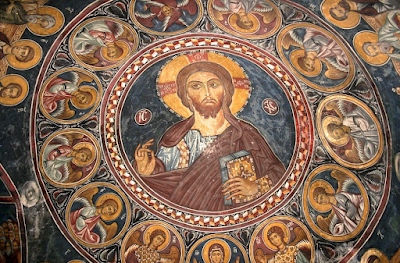The Byzantine Empire, which lasted for over a millennium, left a remarkable mark on the world through its rich culture, art, and architecture. The Byzantine artistic style is unique, combining elements from the Eastern and Western cultures, creating a distinct form of expression. From the stunning mosaics in churches and palaces to the intricate carvings and sculptures, Byzantine art and architecture continue to fascinate people to this day. In this article, we will explore the history, characteristics, and significance of Byzantine art and architecture.
I. Introduction to Byzantine Art and Architecture
Byzantine art and architecture are some of the most iconic and influential styles in the history of art. Developed during the Byzantine Empire, which spanned from the 4th century to the fall of Constantinople in 1453, these styles were heavily influenced by Greek, Roman, and Christian traditions. Byzantine art and architecture are characterized by their elaborate use of gold, intricate mosaics, and rich symbolism, all of which were used to convey religious and political messages.
A. Definition of Byzantine Art and Architecture
Byzantine art and architecture refer to the artistic styles that were developed in the Byzantine Empire. These styles were heavily influenced by Greek and Roman art, as well as Christian iconography and symbolism. Byzantine art is characterized by its use of gold, mosaics, and religious imagery, while Byzantine architecture is known for its elaborate domes, arches, and intricate decoration.
B. Historical Background of the Byzantine Empire
The Byzantine Empire was a continuation of the Eastern Roman Empire, which emerged in the 4th century AD. The empire was centered in Constantinople, which was originally known as Byzantium, and was the capital of the Roman Empire until it was moved to Rome. The Byzantine Empire was a major center of art, culture, and trade, and it played an important role in the development of Western civilization.
The Byzantine Empire faced numerous challenges throughout its history, including invasions by foreign powers, political turmoil, and religious conflict. Despite these challenges, the empire remained a powerful force in the Mediterranean region for centuries, and its art and architecture continue to inspire and influence artists and designers to this day.
II. Characteristics of Byzantine Art and Architecture
A. Religious Influence
Byzantine art and architecture were heavily influenced by religion. The Byzantine Empire was a Christian empire, and this had a profound impact on its art and architecture. Religious figures and scenes were a common subject matter in Byzantine art, and they were often portrayed in a highly stylized and symbolic manner. The Byzantine artists believed that their art should serve a religious purpose, and their works were created to inspire devotion and awe in the viewer.
B. The Use of Mosaics
Mosaics were a defining feature of Byzantine art and architecture. These were intricate designs made up of tiny, colored stones or glass, arranged to create beautiful patterns and scenes. Mosaics were used extensively in churches and palaces, and they often covered entire walls and ceilings. The Byzantine artists used mosaics to tell stories, depict religious figures, and create a sense of grandeur and splendor.
C. The Use of Gold and Precious Stones
Gold and precious stones were highly valued in Byzantine culture, and they were used extensively in art and architecture. Gold was often used in mosaics to create a sense of richness and opulence. Precious stones, such as emeralds, rubies, and sapphires, were also used to decorate the artworks and buildings, adding a touch of luxury and elegance.
D. The Emphasis on Symmetry and Balance
The Byzantine artists placed a great emphasis on symmetry and balance in their art and architecture. This is evident in the use of domes, arches, and columns, which were carefully arranged to create a sense of harmony and balance. The Byzantine artists believed that a work of art or a building should be pleasing to the eye, and that this was achieved through careful attention to symmetry and balance.
E. The Use of the Dome
The dome was a key feature of Byzantine architecture, and it was used in many of the empire's most famous buildings. The dome was used to create a sense of grandeur and awe, and it also allowed for a greater sense of space and light within the building. The Byzantine architects were able to create enormous domes, such as those found in the Hagia Sophia, through the use of innovative engineering techniques.
III. Byzantine Art
A. Iconography
Iconography was an important aspect of Byzantine art, and it refers to the use of religious images and symbols. The Byzantine artists believed that their art should serve a religious purpose, and icons were used to create a sense of reverence and devotion. Icons were highly stylized and symbolic, and they often depicted religious figures such as Christ, the Virgin Mary, and the saints.
B. Mosaics and Frescoes
Mosaics and frescoes were two of the most common forms of Byzantine art. Mosaics were made up of tiny, colored stones or glass, arranged to create intricate patterns and scenes. Frescoes, on the other hand, were painted directly onto the walls of buildings, using wet plaster as a medium. Both forms of art were highly decorative, and they were used to create a sense of grandeur and beauty within the buildings.
C. Illuminated Manuscripts
Illuminated manuscripts were another important form of Byzantine art. These were handwritten books, often containing religious texts or stories, which were decorated with intricate designs and illustrations. Illuminated manuscripts were highly valued, and they were often created by skilled artists who used gold and other precious materials to create stunning works of art.
D. Sculpture and Carvings
Sculpture and carvings were also important forms of Byzantine art, although they were not as prominent as mosaics and frescoes. Sculptures were often created in the round, and they depicted religious figures or scenes. Carvings were also used extensively in Byzantine art and architecture, and they were often made from marble or other types of stone.
IV. Byzantine Architecture
A. Hagia Sophia
The Hagia Sophia is one of the most famous examples of Byzantine architecture. Built in the 6th century, it served as a church for nearly a thousand years before being converted into a mosque in the 15th century. The Hagia Sophia is known for its enormous dome, which was the largest in the world at the time of its construction.
B. The Great Palace of Constantinople
The Great Palace of Constantinople was the official residence of the Byzantine emperors for nearly a thousand years. The palace was an enormous complex of buildings, gardens, and courtyards, and it was renowned for its beauty and grandeur. Unfortunately, the palace was destroyed during the Fourth Crusade in the 13th century, and only a few fragments of it remain today.
C. San Vitale
San Vitale is a church located in Ravenna, Italy, and it is widely considered to be one of the finest examples of Byzantine architecture in the world. The church is known for its elaborate mosaics, which cover the walls and ceilings of the building. The mosaics depict religious figures and scenes, and they are renowned for their intricate beauty and symbolism.
D. The Walls of Constantinople
The Walls of Constantinople were a series of defensive walls and fortifications that protected the city of Constantinople from invasion. The walls were constructed in the 5th century, and they were constantly improved and reinforced over the centuries. The walls were so effective that they were able to withstand multiple sieges, including one by the Ottoman Turks in the 15th century.
V. Conclusion
In conclusion, Byzantine art and architecture were highly influential and innovative forms of art and design. These works of art were heavily influenced by religion, and they were created with a sense of grandeur, beauty, and awe. The use of mosaics, gold, and precious stones, as well as the emphasis on symmetry and balance, helped to create a distinctive style that is still admired and celebrated today.
VI. FAQs
What is the significance of the dome in Byzantine architecture?
The dome was a key feature of Byzantine architecture, and it was used to create a sense of grandeur and awe. It also allowed for a greater sense of space and light within the building.
What is iconography in Byzantine art?
Iconography refers to the use of religious images and symbols in Byzantine art. Icons were highly stylized and symbolic, and they were used to create a sense of reverence and devotion.
What is the Great Palace of Constantinople?
The Great Palace of Constantinople was the official residence of the Byzantine emperors for nearly a thousand years. The palace was an enormous complex of buildings, gardens, and courtyards, and it was renowned for its beauty and grandeur.
What were illuminated manuscripts in Byzantine art?
Illuminated manuscripts were handwritten books, often containing religious texts or stories, which were decorated with intricate designs and illustrations. They were highly valued and often created by skilled artists who used gold and other precious materials to create stunning works of art.
What is the significance of the Walls of Constantinople?
The Walls of Constantinople were a series of defensive walls and fortifications that protected the city of Constantinople from invasion. They were so effective that they were able to withstand multiple sieges, including one by the Ottoman Turks in the 15th century. The walls were a testament to the engineering prowess of the Byzantine Empire and demonstrated their commitment to protecting their city and way of life.
What materials were commonly used in Byzantine art and architecture?
Gold, marble, precious stones, and mosaics were commonly used in Byzantine art and architecture. These materials were used to create beautiful and elaborate works of art that were meant to inspire awe and devotion.
How did Byzantine art and architecture influence later periods of art and design?
Byzantine art and architecture had a profound influence on later periods of art and design, including the Renaissance and Baroque periods. The use of gold and precious materials, the emphasis on symmetry and balance, and the use of religious symbolism and iconography were all hallmarks of Byzantine art and continued to be used in later periods of art and design.
Why was religion such an important influence in Byzantine art and architecture?
Religion was a central part of Byzantine life, and the art and architecture of the period were created to reflect this. Religious figures and scenes were depicted in art and architecture to inspire devotion and reverence, and the use of gold and precious materials was seen as a way to honor the divine.
What is the significance of the Hagia Sophia?
The Hagia Sophia is one of the most famous examples of Byzantine architecture, and it is known for its enormous dome, which was the largest in the world at the time of its construction. The building has served as both a church and a mosque and is a symbol of the complex history and cultural influences of the Byzantine Empire.
How did the Byzantine Empire contribute to the development of art and architecture?
The Byzantine Empire was a major center of art and culture, and its contributions to the development of art and architecture were significant. The use of mosaics, gold, and precious materials, the emphasis on symmetry and balance, and the use of religious symbolism and iconography were all hallmarks of Byzantine art and continued to be used in later periods of art and design.











